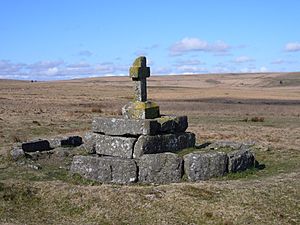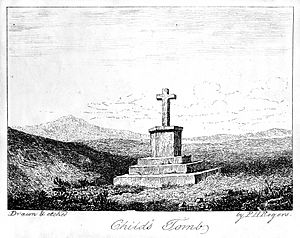Childe's Tomb facts for kids
Childe's Tomb is a special granite cross located on Dartmoor, a wild and beautiful area in Devon, England. While it doesn't look exactly like it did originally, it's more detailed than most other crosses on Dartmoor. It stands on a built-up base, and underneath it, there's an ancient burial chamber called a kistvaen.
A famous legend is connected to this spot. It was first written down in 1630. The story tells of a wealthy hunter named Childe. He got lost in a terrible snowstorm and supposedly died right there. He even tried to stay warm by killing his horse and climbing inside its body for protection. The legend says Childe left a note. It promised his lands at Plymstock to whoever found and buried his body. After a race between the monks of Tavistock Abbey and the people of Plymstock, the Abbey won.
Sadly, the tomb was almost completely destroyed in 1812. A man stole most of its stones to build a house nearby. However, it was partly rebuilt in 1890.
Contents
What Childe's Tomb Looks Like
Childe's Tomb is a granite cross that has been rebuilt. It sits on the south-east edge of Foxtor Mires on Dartmoor, Devon, England. It's about 500 metres north of Fox Tor.
Long ago, the original tomb had a base with three steps. The lowest step was made of four large stones. The two upper steps used eight shorter stones. On top of these steps was an eight-sided block, about three feet tall, with a cross on it.
The tomb is located along a path marked by several stone piles called cairns. This path was an old route for monks, connecting Buckfast Abbey and Tavistock Abbey. The cross was likely put there to help travelers. It was very useful in this part of the moor, where it's easy to get lost in the Foxtor Mires.
Tristram Risdon, who wrote around 1630, said Childe's Tomb was one of three important things in the Forest of Dartmoor. He also mentioned that the original tomb had an inscription. It supposedly said: "They fyrste that fyndes and bringes mee to my grave, The priorie of Plimstoke they shall have." However, no one has ever found any sign of this writing.
Today, the cross is a replacement. It's about 3 feet 4 inches (1 meter) tall and 1 foot 8 inches (0.5 meters) wide at the top. Its base sits in a special stone. This stone rests on a pedestal made of granite blocks. This makes the total height of the cross about 7 feet (2.1 meters). The original, broken stone that held the cross is still nearby. The whole area is surrounded by a circle of granite stones standing on their edges. These stones once surrounded a cairn, which was built over a large kistvaen that is still under the pedestal.
How the Tomb Was Destroyed
In the early 1800s, people became very interested in fencing off parts of Dartmoor. They wanted to "improve" the open land. This was encouraged by Sir Thomas Tyrwhitt's success at Tor Royal near Princetown. New roads, like the one between Ashburton and Two Bridges (opened around 1800), made it easier to reach the moor.
In February 1809, a man named Thomas Windeatt took over a large piece of land. In 1812, Windeatt began building a farmhouse called Fox Tor Farm. His workers took most of the stones from the nearby Childe's Tomb. They used them to build the farmhouse and its doorsteps.
In 1902, William Crossing wrote that an old local man told him something interesting. Some of the granite blocks from the tomb's base were used to make a stone bridge. This bridge crossed a stream near the farm. The old man also said these stones had letters on their undersides. This made Crossing curious. He arranged to lift the bridge, but no inscription was found. However, he did find nine of the twelve stones that made up the original base. He also found the broken stone that held the cross.
Rebuilding the Tomb
William Crossing found the original spot of the tomb again in 1882. He said that only a small mound and some half-buried stones remained. He cleared out the kistvaen, the burial chamber. He reported it was 5 feet 6 inches (1.68 meters) long and 2 feet 8 inches (81 centimeters) wide. Unlike most kistvaens on the moor, its stones seemed to have been shaped by people. This made him think it was not as old as others.
Crossing found most of the original stones. He believed the tomb could be rebuilt easily. However, it didn't happen right away.
J. Brooking Rowe wrote in 1895 that the tomb was rebuilt in 1890. This was done under the direction of Mr. E. Fearnley Tanner. Tanner was not completely happy with the result. Several stones were missing, and it was hard to make it look exactly like the original. Tanner was the secretary of the Dartmoor Preservation Association. This reconstruction was one of the first projects of that group. The new base and cross were made in Holne in 1885.
Childe the Hunter's Story
The legend says the cross was built over the burial chamber of Childe the Hunter. Some believe Childe was Ordulf, the son of Ordgar. Ordgar was an Anglo-Saxon Earl of Devon in the 11th century. The name Childe probably comes from an Old English word. It was used as a title of honor back then.
The story goes that Childe was hunting on the moor with his group. They got caught in bad weather. Childe became separated and got lost. To save himself from freezing to death, he killed his horse. He then crawled inside its warm body for shelter. But he still froze to death. Before he died, he wrote a note. It said that whoever found him and buried him in their church would inherit his Plymstock estate.
The monks of Tavistock Abbey found his body. They started to carry it back to their Abbey. However, they heard about a plan by the people of Plymstock. The Plymstock people wanted to ambush them at a bridge over the River Tavy. So, the monks took a different route. They built a new bridge over the river, just outside Tavistock. They successfully buried Childe's body in the Abbey grounds. Because of this, they inherited the Plymstock estate.
The first time this story was written down was in Risdon's Survey of Devon. This book was finished around 1632.





